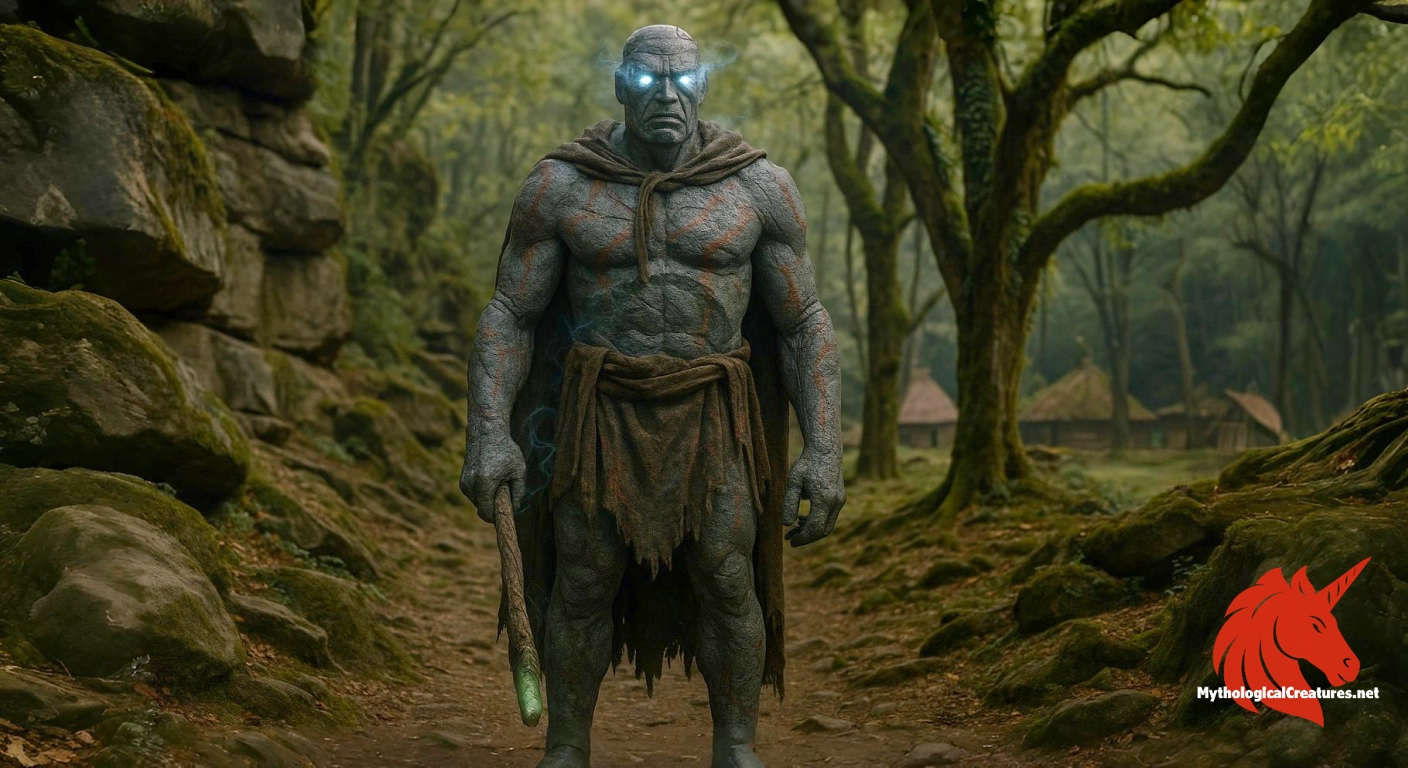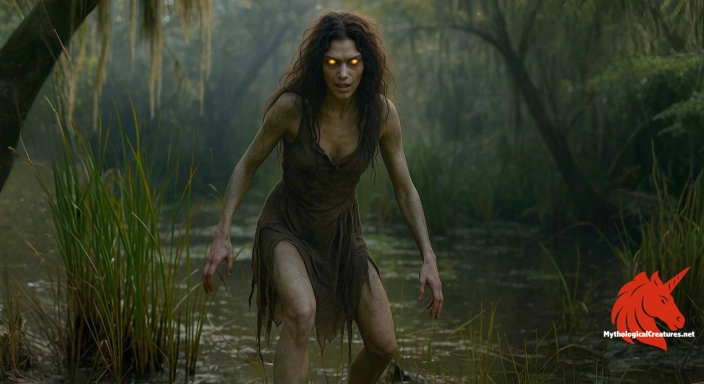Nun'Yunu'Wi: Nun'Yunu'Wi, also known as Stone Coat, is a fearsome mythical being from Cherokee folklore with stone-like, impenetrable skin.

Nun'Yunu'Wi
Nun'Yunu'Wi - Embodies the duality of supernatural might and unexpected vulnerability, serving as a cautionary tale in Cherokee lore.
Origins & First Encounters
Nun'Yunu'Wi, often called Stone Coat, emerges from the rich tapestry of Cherokee mythology with a name that evokes the very essence of stone. Its origins are interwoven with ancient oral traditions, where each telling imbues the being with both mystique and a formidable presence. The creature is depicted in early narratives as having a human-like form yet possessing a skin as hard and unyielding as natural rock. Early accounts introduce it not only as a savage devourer of human life but also as a powerful sorcerer and medicine man, blending the sacred with the sinister. Its magical cane, a symbol of both guidance and lethal potency, directs it towards its unsuspecting victims. The legend reflects a deep cultural context in which supernatural forces were believed to interact directly with the community. Nuanced portrayals highlight the creature’s dual nature, merging both protective spiritual authority and a harbinger of doom. Indigenous storytellers used its myth to weave lessons of respect for ancient customs and the natural order. Throughout its evolution in Cherokee lore, Nun'Yunu'Wi has symbolised both the awe of nature’s power and the caution required when confronting the unknown. Its enduring presence in oral tradition attests to the tight bond between myth, medicine, and moral instruction in the community.
Source Texts & Tale Variants
The narrative of Nun'Yunu'Wi is primarily drawn from Cherokee oral traditions, where the vivid recounting of its deeds has been preserved through generations. Numerous storytellers have contributed to a mosaic of versions that capture its formidable qualities and supernatural abilities. Ancient folklore records describe the being’s stone-like skin as an impenetrable armour against earthly weapons. Multiple versions of the myth highlight the significance of its magical cane, an artefact that seems to possess a will of its own, leading the creature to its victims. One compelling variant recounts a dramatic village encounter, where a strategic use of a unique vulnerability—the creature’s repulsion to menstruating women—became the turning point in its confrontation with humankind. In other strands of the tradition, the focus shifts to its role as both a devourer and a mediator with the spirit world. Some narratives even extend the tale, mentioning how its remains revealed hidden treasures such as a great jewel and mysterious red paint. These story variations, though differing in detail, collectively underscore the creature’s dual identity as both protector and predator. The flexible nature of oral transmission has allowed the myth to adapt, incorporating layers of symbolic meaning while remaining true to its core elements. This adaptability has ensured that Nun'Yunu'Wi continues to intrigue and inspire, resonating deeply within Cherokee cultural memory.
Form & Powers
Nun'Yunu'Wi is consistently described as a humanoid figure imbued with an almost otherworldly physical endurance. Its skin is said to be as hard as stone, rendering it impervious to any conventional weaponry and symbolising a direct link to the earth’s enduring strength. The creature’s facial features combine human familiarity with an eerie, sculptural quality, its eyes often depicted as glowing with an inner light that speaks of ancient magic. The magical cane it wields is another striking aspect, frequently portrayed as a luminous artefact that seems to pulse with supernatural energy. Artistic depictions vary, yet the overall impression is one of rugged solidity mixed with mystical allure. Subtle details, such as hints of red paint or jewel-like adornments seen in some accounts, add layers of symbolic complexity to its already formidable appearance. While most traditions agree on the impenetrable nature of its skin, some versions suggest that its size and physical presence may vary with its magical state. Every described nuance—from the robust musculature to the meticulously carved hands—reinforces its status as both a man and a living embodiment of stone. The amalgamation of natural, unyielding textures with hints of otherworldly embellishment makes its image both terrifying and captivating. Each physical detail of Nun'Yunu'Wi serves as a metaphor for the intertwining of the corporeal and the mystical in Cherokee lore.
Regional Faces
The legend of Nun'Yunu'Wi resonates most vividly within Cherokee communities while also finding echoes among neighbouring indigenous groups. In various local retellings, the being is sometimes portrayed not merely as a menacing monster but as a complex figure straddling the line between guardian and aggressor. Some regional adaptations even hint at a tragic backstory, where a shamanic soul was transformed into this stone-skinned figure through enigmatic rituals. The distinctive detail regarding its vulnerability to the sight of menstruating women persists in many versions, reflecting deeply embedded cultural taboos and beliefs about purity. In several mountain regions, the creature’s narrative has been adapted to serve as a cautionary tale, illustrating the peril associated with tampering in the realms of both spiritual power and natural law. Stories often include the participation of local healers or medicine men whose clever interventions prevent disaster. Certain communities even incorporate ritualistic reenactments of the legendary confrontation, thereby solidifying its place in the local cultural calendar. While the core attributes of stone-like invulnerability and mystical potency remain unchanged, regional variations enrich the tale with diverse motifs and moral lessons. These local adaptations underscore the dynamic nature of indigenous mythmaking, where a single narrative can assume multiple layers of meaning. In every regional variant, Nun'Yunu'Wi serves as a mirror to the social values and spiritual understanding of the people who recount its legend.
Cultural Parallels
Nun'Yunu'Wi occupies a fascinating niche alongside figures in other mythological traditions, reflecting a broader human fascination with beings composed of inanimate elements. Similar in some respects to the golem of Jewish lore or the legendary stone guardians found in European myths, its portrayal as part man and part elemental substance gives it a universal appeal. Unlike some of its parallels, however, the Cherokee Stone Coat is both a formidable beast and a learned medicine man, instilling a worrying ambiguity in its character. This duality—where wisdom meets ruthless power—illustrates how indigenous myths often blur the lines between protector and destroyer. The creature’s extraordinary vulnerability, particularly its aversion to the sight of menstruating women, introduces a unique gendered aspect not commonly found in other mythic beings. In many ways, the magical cane it wields can be seen as a counterpart to other enchanted artefacts, such as the staffs found in varied traditions across the world. Such comparisons reveal a shared motif wherein supernatural powers are channelled through objects imbued with both symbolic and literal potency. The recurring theme of impervious skin contrasts sharply with the subtle weaknesses that ultimately define these beings, bridging the realms of myth and moral instruction. By comparing Nun'Yunu'Wi with similar legends, one appreciates the rich tapestry of narrative strategies used to explore the interplay between the earthly and the divine. These cross-cultural dialogues highlight a universal quest to understand and personify the forces that govern both nature and the human spirit.
Legacy & Modern Evolution
Over the centuries, the legend of Nun'Yunu'Wi has witnessed a remarkable evolution, transitioning from a strictly oral cautionary tale to a subject of modern artistic reinvention. In its original form, the myth served as a profound allegory within Cherokee society, embodying the intricate balance between human frailty and the inexorable forces of nature. As folklore was transcribed and examined in later periods, the creature's story expanded to incorporate themes of retribution, mysticism, and the ever-present clash between ancient wisdom and emerging modernity. Contemporary reinterpretations often cast the Stone Coat in a more nuanced light, sometimes portraying it as a tragic antihero rather than a mere monster. Its vivid imagery and symbolic depth have inspired numerous works in literature, art, and film, where its impenetrable exterior and mystical vulnerabilities carry rich metaphorical weight. Modern discourse has also explored its potential as a symbol for the natural world’s enduring resilience in the face of modern challenges. Scholars and enthusiasts alike appreciate how Nun'Yunu'Wi encapsulates the tension between tradition and technological advancement. Today, its iconography continues to influence fantasy narratives and visual media, ensuring that the legend remains a vibrant part of cultural dialogue. The enduring legacy of Nun'Yunu'Wi is a testament to its profound capacity to evoke both fear and wonder, making it a timeless emblem of the supernatural in Cherokee mythology. Ultimately, this creature stands as a reminder that even the most ancient myths can offer fresh insights when reimagined for the modern era.
Interesting Fact
A striking feature of Nun'Yunu'Wi is its blend of human-like traits with supernatural resilience, yet it is undone by an unconventional weakness that highlights cultural taboos.
Quick Creature Info
Origin:
Features:
Associations:
Our Mythic Legendary Rating:

Also Sometimes Known As:
Habitat:
Supernatural Powers:
Physical Attributes:
Abilities:
Behavior:
Weaknesses:
Lore:
Related Creatures, Tales or Lore
- GGolem
- GGargoyle
- LLiving Statue
References
Discover Another Mythical Legend You May Not Have Heard Of?
Uncover the mysteries of ancient folklore and expand your knowledge of legendary beings from cultures around the world.
Dare to Meet the Abere....
Curated by the Mythological Creatures Team (rev. May 2025)
